
If you’re like most people in the world, you probably love being on Facebook (or one of the other social networks owned by Facebook, like Instagram or WhatsApp). And you’re scrolling through that newsfeed every day, reading the news, looking at pictures of cute cats. We’ve all been there.
In fact, 1.09 billion of you are out there every day, being active on Facebook.
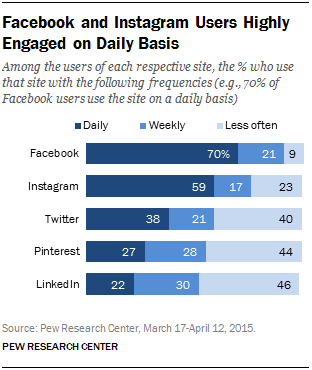
Despite there being some talk in the last couple of months that the reach of Facebook would be on a decline, the data shows that the opposite is pretty much the reality. 70% of Facebook users in the U.S. log into Facebook daily, compared with 59% on Instagram, 38% on Twitter, 27% on Pinterest, and 22% on LinkedIn, according to research done by Pew Research Center.
So being on this platform for you as a business owner makes total sense, right?
And you’ve probably already built a page with an audience over the years as a result. What happened, though?
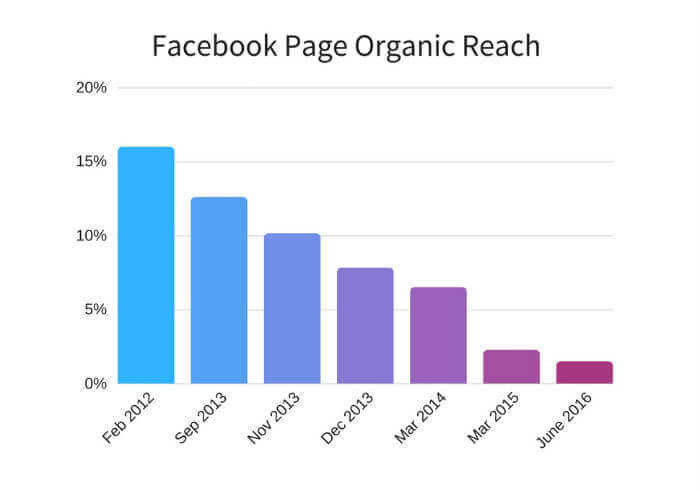
Facebook organic reach for your page has been on a steady decline for these last few years. This means that you as a business have to start using advertising to still get the word out to all those hard-earned followers.
So what do I have to do? Just fill in my credit card and boost those posts?
Well, if you’ve been active in the marketing and advertising world like we have over the past decade, you also start to see a different pattern in the advertising world in general. Television ads are being muted (or people zap to another channel or walk out of the living room), and advertisement online is being blocked. And the people that are still willing to consider reading, watching, or listening to your ads online feel that for them to give you their attention, your ad needs to be compelling and engaging.
This is turning into a real challenge for marketers like yourself.
How can you capture the attention of the right audience at the right time in such a way that they want to stop scrolling (or whatever it is that they are doing) and take notice of your ad?
The answer comes in three parts:
- writing great copy that will compel them to stop what they are doing and read, listen, or watch your ad
- find out where the right audience for your business is so you can target them
- do the analytics so you can learn what is working and what isn’t so you can continuously keep improving.
The beautiful thing about social media, though? The playing field is leveled. Small brands, even mom-and-pop shops, can compete with all the larger ones out there as long as you have the right tools and the creativity to create those compelling ads.
Table of Contents
- How effective is Facebook Advertising?
- What are Facebook Ads
- Why Facebook Advertising works so well
- Best practices for Facebook Ads copywriting
- #1 Make sure your copy fits with your images
- #2 Make sure your copy matches your campaign objective
- #3 Smaller audiences means more effective ads
- #4 Use simple language that even a third-grader can understand
- #5 Use the power of social proof in your ads
- #6 Make it emotional
- #7 Write copy that isn’t about you
- #8 Be sure to anticipate any objections in your ad copy
- #9 Don’t forget the headline
- Five ways for more powerful Facebook Ad headlines
- Ready to craft your own Facebook ad copy?
How effective is Facebook Advertising?
One of the first questions that might come to mind is, should I even be on Facebook and run ads on the platform anymore? After all, you can see the growing competition on this platform amongst businesses so you might think that it is not worth it anymore.
Brands all try to target the same audience as yourself, and people are fed up with the same boring messages repeatedly.
Moving away, though, is not an option. You’d be crazy!
- Just because that organic reach is on its way down doesn’t mean it is gone! And with suitable ads, you can guarantee better visibility for your content.
- Facebook (and its other properties) are the most extensive social network there is; this means that all your customers are there as well.
- Running great ads with the correct Facebook Call-To-Action (CTA) buttons will help you to achieve specific goals.
- The targeting options are more precise than anywhere else you can find online.
- You can target (previous) customers, website visitors, and specific demographics and interests.
- Using their retargeting ads, you can bring back people who would have lost touch with your business.
- You can increase your touchpoints with your audience, create more awareness, and attribute everything to future conversions for tracking.
As you can see, the benefits are endless. You can literally double, triple, or quadruple your business growth with Facebook. Because you can set a daily or lifetime budget because you can increase and decrease your budget at any time, and you are in control of your destiny.
What are Facebook Ads
The moment you start using Facebook is the moment that you, as a person, start sharing your information with the social network. Facebook is using this information to make up a profile about who you are, what you like, what you’re interested in etc. This information is then used to serve advertising in, for example, your newsfeed.
After all, the product is free for everyone to use, but Facebook needs to pay their bills at the end of the day just like everyone else 😉
Brands and marketers who use Facebook use Facebook mainly as a way to reach and talk with their customers, and just like in “the old” days, part of their way of communicating is by using advertising.
The most important thing to remember, though, if you are a brand or marketer for a brand, is the fact that advertisement is mainly seen as an interruption in the life of the person that you’re trying to reach. The life of a person who is more interested in what their friends, families, and other members of their network are posting, liking, sharing, or commenting on the network.
If you want to make sure that your content is “thumb-stopping” to your target audience, you have to make sure that the ad is better than all the other items in their newsfeed.
Why Facebook Advertising works so well
Of course, Facebook is the most extensive social network in the world, so your customers are probably on there too. But that is not the main reason why Facebook advertising works so well.
The biggest reason why Facebook’s advertising works better than all other advertising platforms is the way Facebook allows you to target your audience.
Facebook has the best targeting options of all the other ad networks out there.
This specific targeting allows you to, almost with laser precision, create an ad that will only be seen by the people that YOU want the ad to be seen by.
For example, are you selling Software As A Service (SAAS)? Target people that visited your landing pages and website, and the people that Facebook has identified are identical to these people — selling moving boxes? Target people that are just engaged (and probably will move in with each other), etc.
Some of the ways that Facebook allows you to identify and target your audience are:
- Custom audiences – will enable you to target existing customers or leads (you can upload your existing customer data for this or make a connection to your CRM)
- Location – gives you the ability to target by location (by targeting people in your country, state, city, or even your zip code, you can go very specific for your local business)
- Gender – makes you able to target by gender (male, female, or any of the other options that Facebook offers)
- Interests – will enable you to target by interest (think of things like fitness, entrepreneurship, fashion, literature)
- Behaviors – allows you to target by past behavior (for example, someone who visited your website)
- Connections – makes you able to target people who already like your page or who have connections that do
Best practices for Facebook Ads copywriting
When we would ask you about the best practices for Facebook Ads, what is the thing that comes into your mind first?
Probably visuals and finding the correct targeting audience are the top two items on your list of Facebook Ad success. But what good does the perfect visual, targeted to the ideal customer without any excellent copy lure them further into your funnel?
David Ogilvy, by many, considered the original “Mad Man,” understood the importance of writing a good headline. After all, the visual is the first thing a reader sees, and it will determine whether or not they are interested in reading more.
When asked what his greatest headline ever was? He talks about his 1959 ad for Rolls-Royce:
At 60 miles an hour the loudest noise in the New Rolls-Royce comes from the electric clock.
David Ogilvy
Doesn’t that trigger your curiosity?
So how can you create the best ad that you can create and blow your competitors out of the water?
#1 Make sure your copy fits with your images
First, let’s have a look at the visual, even though the ad copy is what will drive your advertisement home. People first need to stop scrolling from reading the ad.
Most businesses, no matter the size, don’t always have great images at their disposal. This is true for the images that go with their blog post, but this is also true for the images they use in their ads.
Finding or creating great visuals is one thing, though. Finding or creating great visuals that go together with your ad copy is another thing. If the copy of your ad doesn’t match the visual, people will start to wonder what it is that you’re trying to advertise.
When you’re drafting copy for your ads, play around with the placement of the text with other components like images. We often have text overlay on the ad visual. It’s also important to think of the order someone will be reading your text in.
When people scroll through their feeds, the first thing that stops them will often be the image, then they’ll go back and read the accompanying text. Make sure that you’re thinking through this when writing your copy. Finally, make sure that the Text and Headline you use for your ad isn’t just repeating the copy on the image, and that it complements it and adds value for the reader.
Small note, Facebook learned over the years that the best-performing ads have images that almost have no copy on them. In the past, they even made this mandatory with their “20% rule”, a rule that stated that if you wanted to run an image-based ad on Facebook, your visuals were not allowed to have more than 20% text over the visuals. They even created a special tool for you to check if your visuals were compliant with this 20% rule. By now, that rule is no longer a requirement, and they’ve taken the tool offline. But in our experience, it is still smart to follow that 20% rule and try to keep the text on your image-based ads to a minimum.
They probably won’t click on your ad, and the time and effort you put into there are wasted (plus money if you were only looking for impressions with an awareness campaign).
If you’re just starting on Facebook or with your marketing and don’t have a dedicated team in place yet that can help you with the creation of your visuals, have a look at tools like Canva or Pablo by the team behind Buffer.
#2 Make sure your copy matches your campaign objective
Not all businesses are at the same stage in their online marketing journey as others. That means that also, for you and your business, there will be different types of ads depending on how well your (potential) customers already know you. For example, if you’re just starting with your Facebook presence, you probably want to start by running a brand awareness campaign.
If you’re already running Facebook ads for a more extended period, people got to get to know you; you might switch them over to traffic generation ads or page likes (part of the Engagement objective).
When you start creating ads in Facebook Business Manager, you will choose one of these objectives:
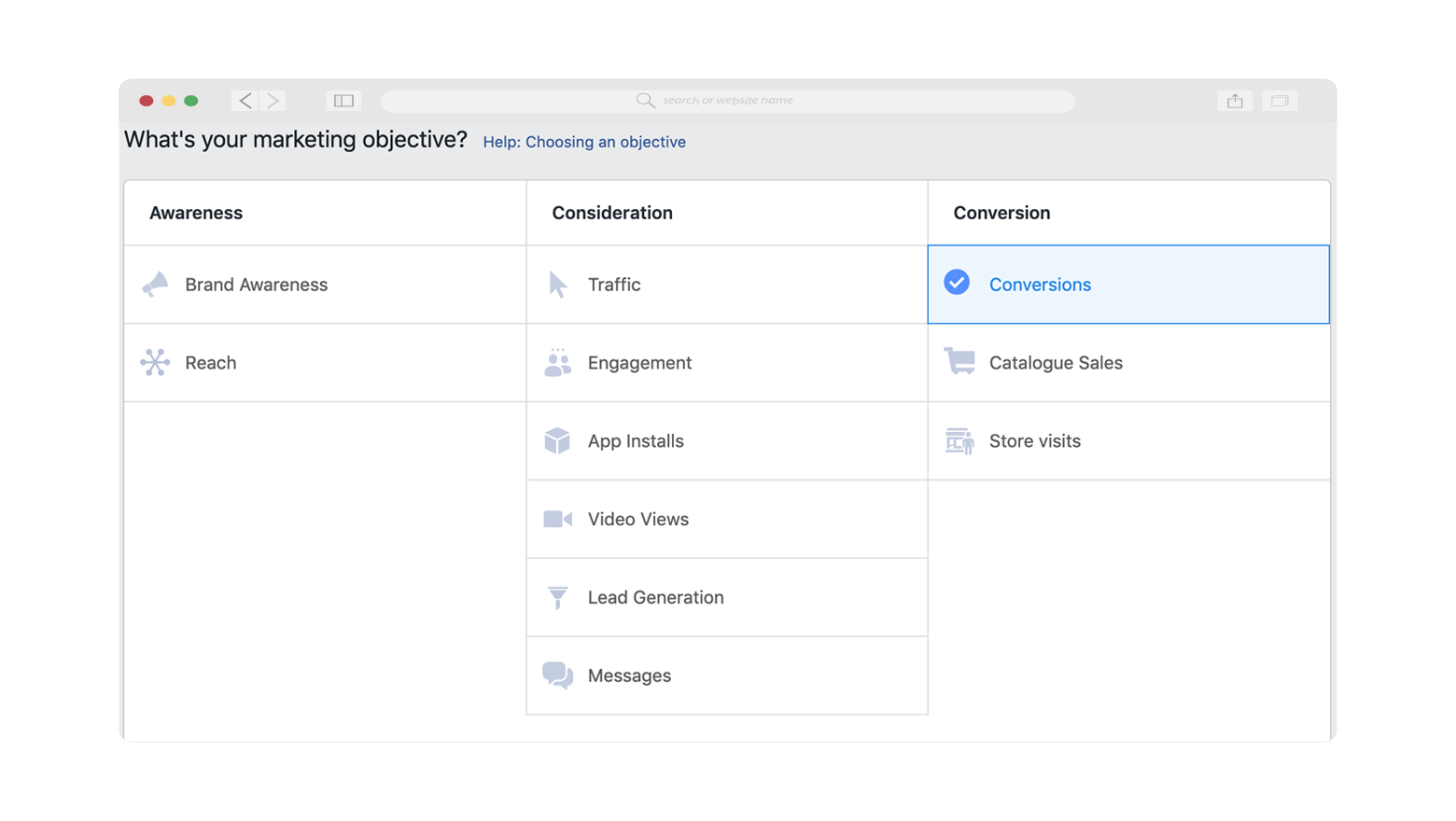
And just like the fact that your visual needs to correlate to the copy you’re writing, so does the context of your copy need to be adapted to the objective you’re setting. Think of it this way, would you approach someone with the same copy when you want to drive more installs for your app or more visits to your store as you would want to have simply more traffic to your website?
Of course not.
Different objectives mean different visuals and different ad copy. When you start by taking care of those first two points, you will already be well on your way.
#3 Smaller audiences means more effective ads
One of the most beautiful things about ads on Facebook compared to “traditional” advertising is? You can narrow your target audience to the exact specifications you want.
Think of it like this: your (potential) customers come to you for various reasons, so why would you use the same ad? Facebook’s strength is its targeting ability, so don’t treat your ad like a billboard.
Facebook’s strength is its ability to target, so don’t treat your ad like a billboard.Click To TweetThis means that when you narrow down your audience, you can tailor your copy to make it just perfect for that ideal customer.
When you’re creating content online, as we do in this blog post here, it is customary to write like you’re speaking at a conference. Although we address you, it is still broad enough for a bigger audience.
If you want to create an effective ad copy, though, be sure to narrow the audience to which you’re targeting to make it as small as possible. When you do that, you can write as if you’re talking to just one person. Talking to one person, it makes it easier to persuade them.
So where to start? You can begin by creating your Buyer Persona (or ideal customer). Although that is one of those fancy marketing terms, it sounds more complicated as it is. If you just take a little bit of time, you can probably answer questions about your target audience like:
- How old are they?
- Where do they live?
- What does a typical day in their life look like?
- What keeps them up at night?
- What are they interested in?
When you’re trying to gather all this information about your audience, it helps if you have a tool that helps you to discover all sorts of related interests to the interests you already know about your customer. Deeper interests that your competitor probably doesn’t know anything about. You can use the Facebook Audience builder (part of Facebook Business Manager) to figure out the potential size of your audience, but Facebook keeps the biggest part of these so-called interests hidden. Only accessible via their API and not available for the average user as a result.
We, here at User Growth, thought that, as a result, you’re missing out on a tonne of information. Information that you can use to your advantage (since your competitors don’t have this information as well), so we build a free tool for you called Audience Builder to discover all these hidden interests so that you can laser-target interests without the need for advanced programming skills.
If you’ve ever been limited by Facebook Ad Managers’ and Insights’ limited interests, Audience Builder is the solution for you.
Bonus tip: In your copy, make it clear to your audience that you feel their pains, and for example, when you narrow down your target audience well enough, don’t be afraid to mention their job title within your text. This is a great way to stand out in the News Feed and have your audiences thinking, “Hey, that’s me!”
#4 Use simple language that even a third-grader can understand
For anyone working in any industry for a longer period, it means you get fully sucked into all the jargon that is being used in your industry. And these fancy, big words might be cool around the office when it comes to writing for a lot of people, but this type of copy is hard to understand.
The result in a lack of clarity in your copy?
People are skipping your ad and moving on to scrolling through their newsfeeds. After all the optimizations you made in your ad copy up until now, this one should be your next priority.
Writing a Facebook ad that everyone can understand, even a third-grader. Do you want to grab the reader’s attention, let alone spark conversions? Write your ads in such a way that when someone sees your ad, they immediately know:
- What it is that you’re offering, what problem are you solving
- What is your solution, and how it benefits the reader
- What they need to do next
Nothing makes a Facebook user scroll past your ad faster than lengthy sentences that are too complicated to understand on the first read. Think of your copy as an elevator pitch you’re giving to a kid that’s looking for a very specific solution.
Keeping it simple and to the point can be very challenging, especially when you think you have much to say. It is okay not to describe every little aspect of the product, service, or promotion you have in your advertisement.
Remember that headline copy from David Ogilvy in the beginning? Did he talk about all the different features that car had and why it was better than the other cars? Nope, he identified the goal he wanted to get across and wrote one small sentence around it, enough to spark the curiosity of the reader and get them to move forward down the funnel.
Do you want the reader of your ad to download an eBook? Sign up for a webinar? Figure out what it is you want them to do and use clear, short Call-To-Actions that will guide the reader in the direction you want.
Of course, trying to do all of the above in one sentence while still being creative is not something you learn overnight. But it can be done, and the beautiful thing about Facebook Ads is that you can test all variations of your copy simultaneously, so you can identify the winning copy and get better results for less money.
Bonus tip: To make your copywriting easy to read, make it easy to pronounce.
#5 Use the power of social proof in your ads
Trust is something hard-earned. When done well, it can make people comfortable enough to hand over their hard-earned money in a split second, personal information, or something else that seems valuable to them. But if there is no trust yet, if they’ve never heard of you, how can you earn that trust quickly enough? Earn trust in just one ad?
Most people like to look in general for “signs” that build that trust to make something trustworthy.
As a result, the actions of others can reflect on your company, your product, or your service. This is what social proof is all about. Social proof can be done in lots of different ways. Think about the number of social shares, comments, and other forms of engagement that people can have on your ads.
Or what about using testimonials from existing customers or clients in your ads and copy?
For example, you can use reviews of top-rated, best-selling products to attract people to buy specific items, as Nations Photo Lab has done in the past:
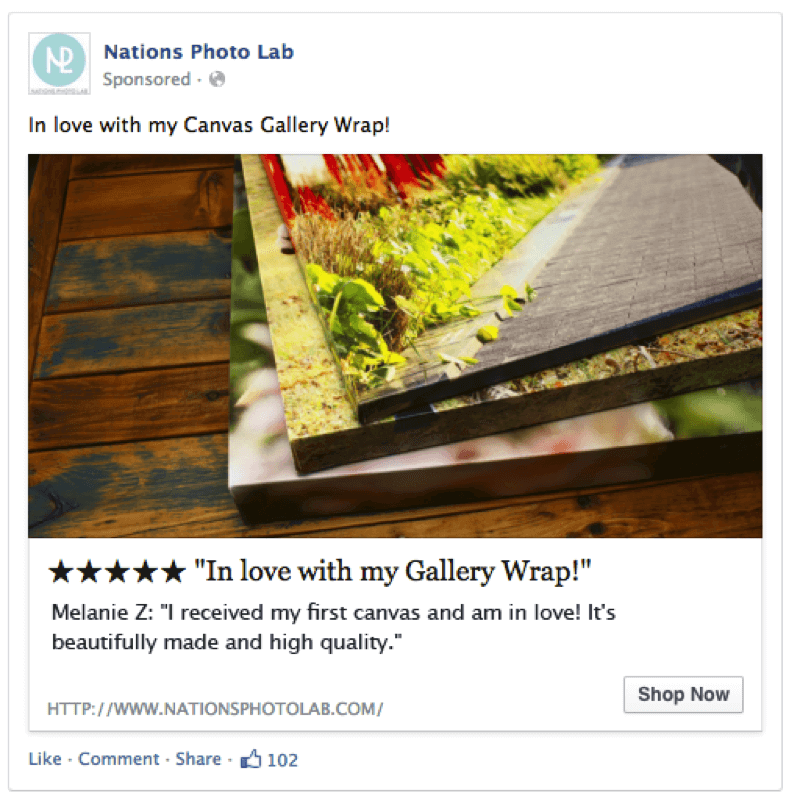
The moment people visited your website and do not go for the conversion, build that extra trust by showing site reviews instead of product reviews:
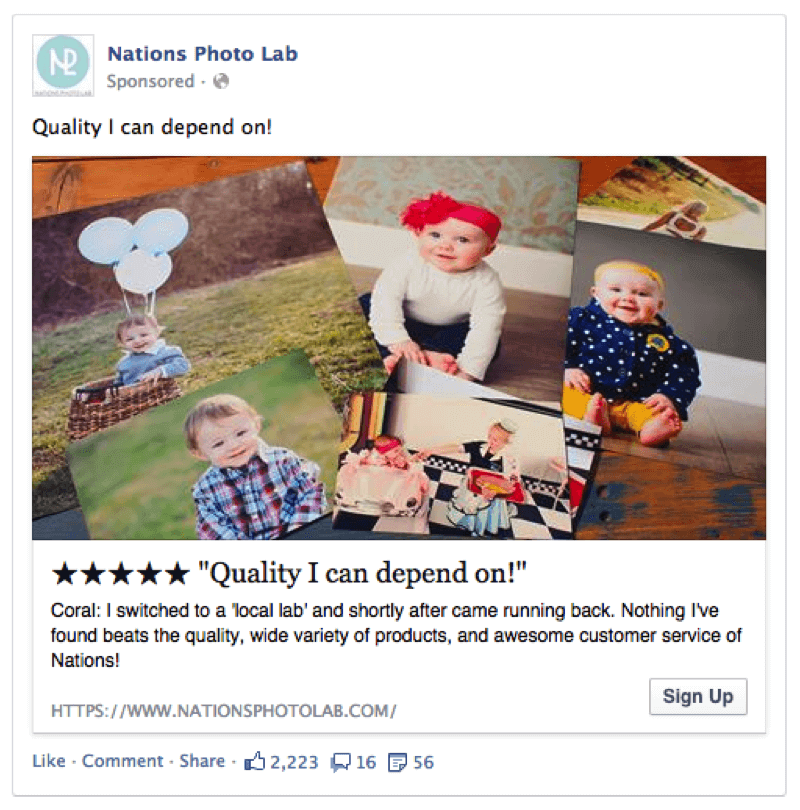
Why? Well, although you can attract people with a great product, they probably won’t buy because they have never heard from you. What better way to show trust than by showing reviews to them that you deliver on your promise? That they can count on you? Reviews like this will reinforce your brand even if the visitors don’t want to buy a specific product.
Another great way to use testimonials is with the carousel ad format. This format allows you to tell a story in which you can include multiple reviews. Guiding the reader through the entire Customer Journey in one time.
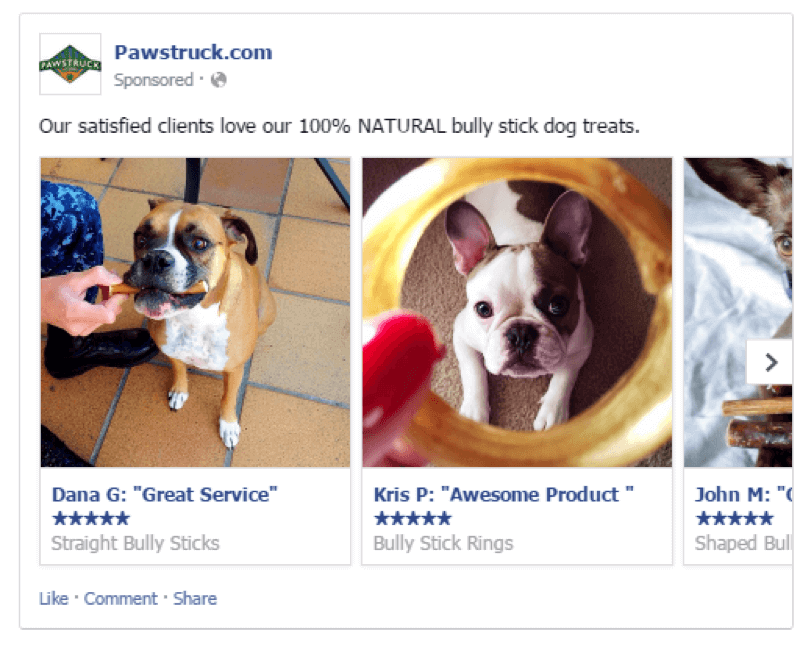
There are lots of different ways you can incorporate raving reviews and testimonials of your customers in your ad copy. Conversion guaranteed!
#6 Make it emotional
When writing copy for ads, one of the things you might easily overlook is the power of emotions. A study done by Hamish Pringle and Peter Field in their book “Brand Immortality: How Brands Can Live Long and Prosper” shows emotional ads work best. They analyzed 1,400 successful ad campaign case studies and found that the campaigns with purely emotional content performed about twice as well as campaigns with only rational content (31% versus 16%, to be exact).
Next to that Trend, Hunter Marketing did some more research on 37 emotional marketing campaigns. The results? The average popularity score was 8.0, way higher than in other categories.
As you can see, using emotions in ad copy is not only valuable to use as part of your holiday marketing campaigns, but they are useful the entire year.
If you use emotion in your Facebook ad campaigns, you can make your target audience click and purchase, and the great thing is that there are a lot of different emotions you can use. Think of ways to excite your audience, delight them, and shock them. What’s holding you back?
The easiest one to use and start thinking of already is using a bit of drama.
Think of it like this: why does your company exist? You exist because you saw a problem that needs solving, right? This means that there are people who are “suffering” in some way, and your product or service can end their suffering. Sounds like a long shot? Maybe. But think of it like this: even though your audience might not lose any sleep over the fact that they have a problem, they might still be losing money without your solution.
Most industries are perfect for ads like this: life coaching, health, and neutron, personal finance, you name it, and you can probably write some emotional copy. Think about the fears your customers have, the mindset that is holding them back, or maybe they are experiencing some other emotions you can think of.
Use those and speak to those emotions.
Want some specific examples of how you can trigger emotions in your readers?
6.1 Using FOMO
Did you ever buy a product online because of a timer running on the website, saying there is only a limited time left before this deal disappears forever? If you did, it was probably because of a phenomenon first identified by the marketing strategist dr. Herman, in 1996, called the Fear Of Missing Out (FOMO)
What if all your friends are at this great party and you miss out on all the fun….
Eventbrite conducted a study on millennials and found that as many as 69% experience FOMO when they can’t go to an event and their friends are going.
People are afraid that they will miss out on an experience or any other aspect of life and business. You can use this to your advantage in your advertisement copy, for example, by combining it with social proof using celebrities.

UNICEF does this well by showing Orlando Bloom and the chance to join him in Malibu. It makes you feel that you’re missing out on something.
Or Elegant Themes, combining their ad with social proof using the power of numbers. If you have a large number of people using your app or service, you can tell this in your ad copy.
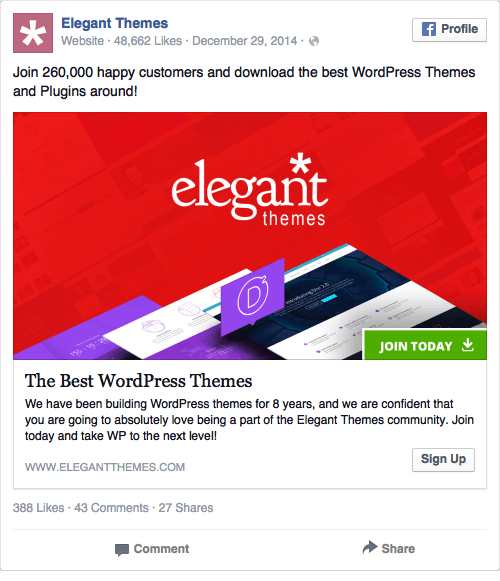
Elegant Themes does this well by showing 26.000 people are using their service. It makes you feel you’re missing out on something as a reader if so many people use this service.
Other ways you can use FOMO in your ads include:
- If you phrase your copy as a question, hinting that the reader is missing out on a great opportunity;
- In your copy, you could make the reader feel like there is an entire community they’re not a part of… yet if they would only start using your product
- Using time-based ad copy, “Only 24 hours left before this deal disappears forever”, you can nudge people to sign-up faster
6.2 Get people excited
When people get excited, it will increase their impulsiveness; it lets people make a decision quickly without fully rationalizing it.
This means if you’re able to make a person excited about the offer you place in your Facebook ad, there is a higher probability that they will make the “purchase”.
There is, however, a time element in play when using excitement. An article from 2014 in the Wall Street Journal suggests that the feeling of excitement can pass in only 20 minutes.
As a result, you should keep your landing page that comes after the ad as straightforward and compelling as possible if you want visitors to convert.
Want to use excitement in your ads? Try one of the following:
- using bright colors in the ad design
- keeping your ad copy short, using exclamation marks
- aligning your visual showing a lot of excitement
- showing your product at the most exciting moment when people are using it
- making the offer interesting to your target audience, making sure you target the right audience
- include a discount in the ad to give a final nudge and make it truly irresistible
6.3 Creating curiosity
Have you ever clicked on a Buzzfeed article and thought, how did I end up here?
The answer is called “the curiosity gap.”
If your goal is just having people click through to your website, this tactic does wonders. Joanna Wiebe from Copyhackers used this technique to get a 927% boost in clicks on her Pricing page. If this works on your website, why not also try it out in your ads?
Want to know the secret formula to the curiosity gap? It’s really easy; use your ad copy to ask a fascinating question or tell the reader a great story, and the only thing you have to do is leave the best part out.
Ask people a fascinating question or tell them a cool story, and leave the best part untold is a great way to get clicksClick To TweetThe reason why this works is the fact that everyone has a natural tendency to connect the dots to discover the answers. As a result, it will be hard for your reader to resist reading it and not clicking through if the question is fascinating enough.
The warmer your audience, the more you can even try to get in return. Maybe you can try to capture an email address before giving the final answer!
6.4 Use power words
Power words are words that grab your attention fast. They are words used to trigger an emotional or psychological response. They are so persuasive that your readers simply can’t resist by being influenced by them.
Words like You or NOW or BEST or INSANE. Words like this tap into a deep-rooted emotional fear and aspiration. According to research done by OptinMonster, you can increase your conversions by 12.7% is you start using these types of words.
And the most beautiful thing? They can be applied to almost every business or subject. It helps you to tap into greed, lust, vanity, trust, curiosity, and so much more feelings of your readers.
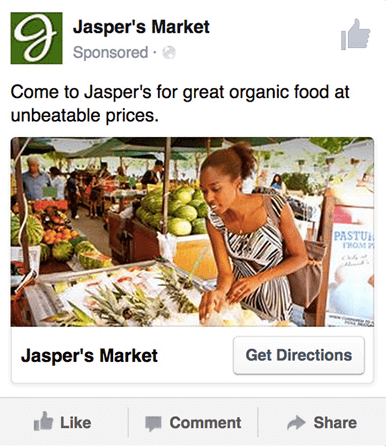
For example, look at the above ad by Jasper’s Market. It is talking about GREAT organic food at UNBEATABLE prices. With a clear Call-To-Action to get the directions, you can start shopping immediately.
If you tap into the desire of your reader, you can for sure increase their motivation to click on your ads.
Want to use power words in your ads?
Be sure first to analyze the psychology behind what drives your target audience. This includes their motivation. What are they looking for, and how can you communicate those benefits clearly?
#7 Write copy that isn’t about you
Most businesses, when you look at their websites and their ad copy, they care about themselves. You care about yourself. Just like your mother or your spouse cares about you. The harsh reality, though, is that when people see your ad for the first time, they don’t know you. They don’t care about your company.
You probably don’t have people clicking on your ads who want to learn about your company. They are not clicking on your ad because you worked your ass off for the last six months to create a product or service. Maybe at one point, when you’ve interacted a lot with them, and they’ve turned into fans of your product or service, but before that, they don’t care about you.
Or as Neville from Kopywriting Kourse says:
People don’t care about you, they only care about themselves. - Neville MedhoraClick To TweetAnd since your prospects only care about themselves, your message has to be on point with what they want. It has to sound like it is all about them. You’re not selling a product; you’re not selling a service. You’re selling your prospect a better version of themselves. A fitter, happier, more productive version of themselves.
And although this sounds like something easy to do, a lot of companies have trouble doing this right. They break this rule by writing business-centric copy instead of customer-centric copy. They write about how they are the best in the world, their product is super awesome, or something like this, and they fail to focus on their customers and sell them what they are looking for.
So how do you write customer-centric copy?
When writing customer-centric copy, you need to use the word “you” instead of “we.” It is that simple. When you switch most instances in your copy from “we” to “you,” you immediately switch the focus from business-centric to customer-centric.
A good rule of thumb (depending on the length of the copy in your ad, of course) is to try to use the word “you” twice as much as the words “we” and “us” or “me” and “I.” For example, instead of saying:
“We’re a professional house cleaning service based in San Francisco, California. We have the best rates in town. Our cleaners are professional and punctual.”
Try saying:
“Are you tired of cleaning your own home? Do you have better things to do with your time? We’re glad you stopped scrolling your newsfeed. Our cleaning service specializes in helping busy professionals like yourself.”
#8 Be sure to anticipate any objections in your ad copy
Legendary advertising copywriter Joseph Superman mentions anticipating and resolving objections in his book Advertising Secrets of the Written Word as one of the powerful copy elements to successful selling.
If you’ve got the feeling that the reader of your ads might have some objection after reading your copy, an objection that prevents them from converting, you should raise this objection yourself. You must anticipate it so that you can fight it.
The sooner you do this in your copy, the better. In a normal conversation, you will be able to sense what the next question will be, but when you’re not conversing with your prospect or not in front of her, you should anticipate this yourself.
If you sense that there could be an objection or a reason for not converting, and you decide to ignore it, it is almost like you are ignoring your potential customer. And does that sound like something you would do in a one-to-one conversation? Of course not!
But being able to recognize an objection is not enough. You must take the opportunity and resolve it. What is the best way to resolve them? By being honest about it, providing different solutions, or making the entire objection disappear entirely.
When someone reads your ad copy for your meal delivery service, they assume that it will be too expensive. Or that watch you’re trying to sell will be made out of cheap material and fall apart the moment you open the box.
A great example of an ad removing objections is the example of Apple below.
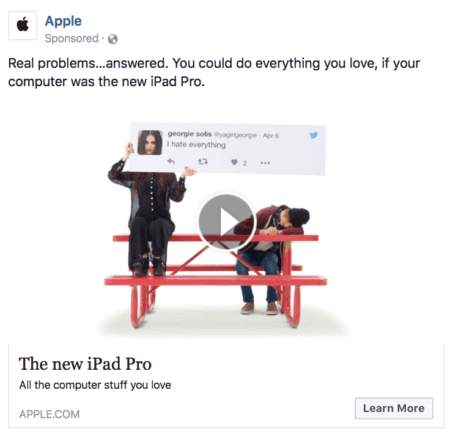
When considering buying an iPad Pro, what is the first thing that comes to mind? Probably something like, “can it do everything that I can currently do on my computer?”. The straightforward copy of Apple takes away that objection and reminds the reader that the new iPad Pro can do “all the computer stuff you love.”
When you have the opportunity to try talking to your existing users. What held them back before they started using your product or service? What parts of your product or service took away that fear? Use these elements when writing your next ad.
Only by making sure that your copy doesn’t bring in any objections, and if it does, puts them to rest immediately, can you make sure that you will bring in those last set of doubters into your client base. In some cases, just adding one word to your copy can help prevent any objections from ruining your ad’s potential. Saying “affordable meal delivery service” or “durable watch” can offset the potential objections from the get-go.
#9 Don’t forget the headline
Ah, the headline of your ad, the optimizing you’ve been doing up until now. There is one thing we did not address yet. And although we did not talk about it yet, it doesn’t mean it is of no importance. In fact, some might even say it is the essential thing in any ad.
After all, most people don’t even read past the headline. Whether we’re talking about a landing page, a news article, an email subject line, or ad copy. Most people don’t read further than the headline. This means you have to make your ad headlines on Facebook count!
When your company is competing with an enormous amount of others on Facebook, trying to get the readers’ attention, you have to distinguish yourself and fast. The best place to start is the headline.
So, if you want people to click your ad, you need an outstanding headline. A headline that highlights your Unique Value Proposition, a headline that lets your prospects how why you’re the best, why you’re different from your competitors, or what is so special about your product or service. Make them feel like they don’t have a choice but to click your ad.
Research done by AdEspresso shows the average length for a Facebook ad headline should be just five words.
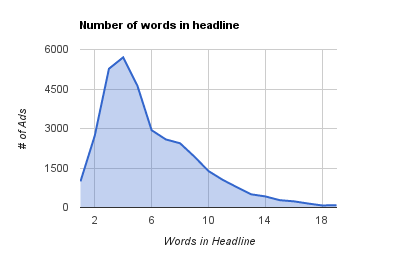
A headline should not tell your life’s story. It is just there to grab their attention, to let them stop scrolling. If you make your headline too long, it can cause people to lose focus and attention. Make your headline clear, concise, and focused on your value proposition. All the rest of the info you want to give to the reader, you can put in the rest of your ad copy and link description.
A great example of a powerful headline is this ad by Asana:
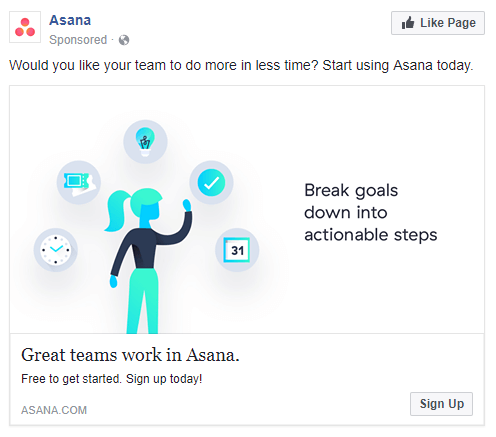
The headline is short, simple, and very matter-of-fact. If your ideal prospect were only to read the headline of this ad, they’d see that great teams work in Asana. Why wouldn’t they want to do the same?
If you want to create powerful Facebook ad headlines, your headline should be:
- Customized: If you want to make your Ad more personal and engaging, customize the headline. Use a different headline for a different audience.
- Clear and concise: we just told you about making it no more than five words. If you make it longer, you end up including lots of weak words. Remove the excess words and keep only those that are meaningful. If you do this, your message will become a lot clearer
- Creating a sense of urgency: If you want your audience to act quickly, you should create a sense of urgency. Using words like “limited,” “now,” “act now,” “last chance,” etc. do wonders to create a sense of urgency.
- Using numbers: by using numbers, you can turn something vague into something specific. Research done by CopyBlogger shows how powerful this can be
Five ways for more powerful Facebook Ad headlines
Now that you know the theory behind writing stronger, more powerful headlines on your Facebook ads, let’s have a quick look into how to do this in your ads.
Asking questions
The easiest way to write an engaging headline is to make it in the form of a question. Questions always grab people’s attention and draw them to get the answer. Research done by Social Influence even goes as far as stating that headlines in the form of questions received 150% more clicks than statement headlines. Including the word “you” in a questioning headline made it receive even 175% more clicks!
Giving an order
Another great way to make your ad headline more powerful is when you use commands in your headlines to help inspire interest. Frances Ylana, a visual communication lecturer at the University of Texas, suggests when crafting an effective Facebook ad headline, you should start by communicating the command or action you want the reader to take upfront. It becomes even more powerful when you use the other elements of your ad, like your visuals, the descriptions, etc., to paint the full picture.
Combining these different elements into a full ad helps you to keep things clear, concise, and actionable while it is still compelling to watch and read.
Listing a benefit
This one is a bit in line with the previous point about taking away any objections your readers might have. If you can show the benefits of your product or service to your user in a headline this can do wonders as well.
Don’t automatically try to sell something to the reader, but rather try to help them. According to a piece on Entrepreneur, a headline that clearly states how your offer will benefit the reader is a better way to drive clicks and conversions instead of just listing the features.
Inspiring curiosity
We already talked about curiosity before in the emotional part of your copy. Curiosity also does great for your headlines, though. According to George Loewenstein of Carnegie Mellon University, there is this concept called the curiosity gap or the gap between “what we know and what we don’t know.”
The theory is based on the fact that if you only give a person half of the information, he or she likes to fill in the blank with new information.
Some more research even found that curiosity activates the reward-seeking parts of your brand.
So how can you apply this to your Facebook ad headlines? Simple, for the reader of your ad, it is almost painful to find out there is something they don’t know until they can fix it by learning something new. If you create an ad headline that acts as a teaser to the content on your website, it can inspire curiosity and earn you clicks on your campaigns.
Leveraging lists
The last thing we want to address is listicles. Maria Konnikova thinks that the reasons why listicles have grown so popular over the last couple of years have to do with how your brain works.
When your brain sees some form of information, it tries to process what it is reading. Numbers are a great way to help break up all of the written content that you’re exposed to on a daily basis.
Complimentary research states that numbered lists make it easier for you to categorize and draw on differences between data. As a result, it helps you to process it more quickly.
Ready to craft your own Facebook ad copy?
Facebook Ads can help you and your business move forward in ways that were impossible a decade ago. It is one of the most powerful advertising platforms out there. If you follow the above instructions, you will have the knowledge to write copy that uses that ad platform and take your business to the next level.
Your Facebook ad copy should be:
- fitting with your images
- matching your campaign objective
- targeted to smaller audiences so that you can have more effective ads
- using simple language that even a third-grader can understand
- using the power of social proof in your ads
- emotional
- about your customer, not about you
- anticipating any objections your (potential customers might have)
- have a powerful headline
Remember, the overall goal of your ads is to engage with your audience and make them subscribe to your offer.
If you follow these nine steps to write incredible Facebook ad copy, you will be miles ahead of the majority of your competition. Giving you the results you need.
If we can give one final piece of advice, it is that you should never stop testing. Use that split-testing feature in Facebook Business Manager whenever you can, test, rewrite and test again! By doing so, you will achieve your desired results even faster.
While you optimize your ad copy, don’t forget to use our free tool, Audience Builder, to target untapped, highly-specific audience interests!
Are you still doubting your ad copy? Looking for some extra pairs of eyes on them? If you need extra help, drop a comment below, and we’d be happy to provide feedback!
What do you think? Are these tips helpful? What steps are you taking to ensure you write the best Facebook ad copy you can? How do you increase the ROI of your ads? Leave us a comment below, and let us know what you think!
Want to learn more about growing your business through digital marketing? Looking to take your business to the next level? Let’s talk!
If you want you can easily unsubscribe with a single click at any time.


I like the thought that advertisement is mostly seen as an interruption in the life of the person that you’re trying to reach. And every time we create content for an ad it should be on our minds.
[…] the power of social proof in your ads,” says Hans van Gent of User Growth. “If people have never heard of you, how can you earn their trust as quickly as just in one […]
[…] user-generated campaigns through your own customers and highlighting buyers through social proof on your website and in your ads as a result will have a higher ROI than just retargeting them using ads on social […]